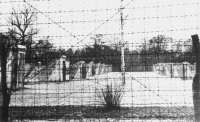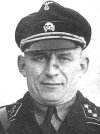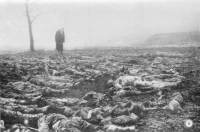 |
 |
 |
 |
 |
 |
The Syretsky camp was a sub-camp of KZ Sachsenhausen. It was situated at the north-western edge of Kiev, in the place called Syrets, today a suburb of the city. It was the location of the former summer camps of the Kiev garrison, by the slope of the Babiy Yar ravine. The Syretsky concentration camp was created in spring of 1942. It served to intern POWs, partisans, and Jews who had survived the mass actions of September - October 1941. Before the camp was established, there was a concentration camp on Kerosinnaja Street (now Sholudenko Street).
Until June 1942 inmates lived in the open air. The camp was guarded by Ukrainian policemen and German SS men. The commandant was SS-Sturmbannführer Paul von Radomski.
More than 3,000 inmates were interned in the camp at any given time.
F. Zubchenko, a private in the 23rd SS police battalion, testified:
 |
| View through the Fence |
Former inmate David Budnik:
“Obersturmbahnführer Radomsky and his assistant Reder created a barbaric regime designed to destroy people in every possible way. The operation was supervised by the interpreter Rein, a Volksdeutscher
 |
| The Dug-Outs |
Former inmate Yakov Kaper:
"Near the entrance to the camp they built a Wachstube. At the camp corners there were high watchtowers, manned by policemen with machine-guns. Inside the camp there was a fenced-in women's camp, then a road, then our dug-outs in two rows, also fenced in. The first dug-out on the right side, near the entrance to zone no. 2, was for the Jews. Gallows were specially installed near our dug-out... On the very day that we arrived, one man who tried to escape was hanged on these gallows. There followed a long row of dug-outs, which also had names – “Soviet”, “Partisan”, “Communist”. On the left - in dug-outs with odd numbers starting with 1 - were the most significant authorities; - Anton, Rostislav, Boyarsky and several other Sotniks. Then came the brigade-leaders' dug-out, followed by others... The last dug-out was sanitary, for the sick."
According to former inmates, at first there were 16 dug-outs, later 32.
In the summer of 1942 shipyard workers were arrested and brought to the Syretsky camp. One of them, S. Soya, survived and testified about their treatment:
"I lived in that camp for 15 months... there were 8 of us... none of the others survived apart from a joiner, I don't remember his surname, because he escaped. On the third day after our arrival from the Gestapo, one man from our company of water-transport workers died because of a severe beating he had suffered at their hands, and two other men died for the same reason after a week. The rest died in the camp from hunger... In the concentration camp we were used for hard labour, but they fed us very poorly, so that the daily mortality was 10 -15 people."
Budnik:
“… They beat us, tortured us, ordered us to lie down, then to stand up, then to squat. We were robbed of our clothes and shoes, if they were considered worth taking and left with only our underwear ... Yellow stars were not worn here because all the Jews were known and identified. We later learned that in every Jew's identity card there was a permanent notation. There was only one road out here for us... to Babi Yar
… Almost every day new prisoners arrived. They were examined, lined up and transferred over to Anton and his assistants. Their clothes, if considered nice enough, were exchanged for food and drinks. Then, the half-naked prisoners were drilled and beaten, as we had been given on our first day.
Those who had no profession suffered most because tortures were considered worst at the general works. For example, if trees needed to be cut down, one of the prisoners had to climb the tree and fasten himself to the trunk. Then the tree was cut down. If the prisoner was still breathing after the fall, they beat him to death. Many people died every day and were replaced by new prisoners who soon met a similar fate.
During roll-call, the camp overseer conveyed to the authorities anything that needed to be reported. The smallest error was punished by a beating. The prisoner would get as many blows or lashes as he could stand.”
Yakov Kaper:
 |
| v. Radomski |
A special table was placed in the centre of the grounds for whipping people. The prisoner who was to be punished was ordered to take off his trousers and to lie face down on the table. His neck and feet were then fixed to boards so that he could not move. The strongest men were chosen from the ranks and ordered to administer as many blows as were prescribed. They would beat the other prisoner so hard that his flesh flew around. Those who did not hit hard enough were then themselves tied to the table and beaten by others. Many times the victim could not get up after the beating and Radomsky would shoot him on the spot.”
The Czech Anton Prokupek (a former steam-locomotive driver) was head of the men's section, and was often called a "commandant" by inmates.
The first women appeared in the camp in September of 1942. They lived in a wooden barrack.
Budnik:
"They peeled potatoes, cooked, served meals, sewed, mended clothes, cleaned the area, and made a type of shoe from cord. In theory these were for the prisoners, but none of us ever received a pair. Among them were juveniles, young Jewish girls whose parents had been shot. They were given the hardest labour. They loaded carts with stones and bricks and then they were harnessed to the carts in place of horses. They were urged on with sticks and lashes. It was unbearable to watch how both the criminals and the fascists taunted them simply because they were Jewish. To make them easily identifiable all of their hair was cut off.”
The male inmates’ work consisted of rooting out stumps, preparing firewood, building and repairing barracks, creation of charcoal from wood, the dismantling of nearby houses, etc. Inmates were taunted, tortured, and murdered. Sotnik I. Morozov testified about the crimes of other Sotniks:
"In July /August 1942, they were cutting trees on the camp territory. (Viktor) Konrad and Kuripko forced Jews to climb up trees. The sawn tree was pulled with a rope, and fell, together with the inmate, who then lay on the ground, mutilated."
According to testimonies, Sotnik Konrad was hanging inmates on the gallows himself. After work he also forced Jews to dance together in a circle with other inmates on their shoulders, and to sing Jewish songs.
Sotnik Morozov described the camp regime in detail:
"Roused at 4 o'clock in the morning: 4:30 - breakfast, 5 o'clock - marching to work in formations. At 12 noon - dinner: one hour later - return to work until 9 o'clock in the evening. In the morning they were given a cup of so-called coffee (boiled water with a taste of some herb). For dinner a litre of some "soup" - just water without salt, with several grains of millet. 200 grams of bread made from millet flour was provided for an entire day. There was no supper. Inmates ate rats, dogs, cats, different herbs. They were swelling from hunger. People in this condition were taken to the so-called 'hospital' - a dug-out, where there was no medical help, and people just died, or were shot by the German camp commandant, Radomski.
In 1942, Radomski was shooting sick inmates almost daily. He entered the hospital dug-out, ordered the sick to be taken out, and here, near the dug-out, he was shooting them."
Bodies of the shot were buried in pits on the camp territory or were taken to nearby Babiy Yar.
There were several escape attempts. Thus, according to policeman Rumyantsev, at the end of July 1943 5 Soviet POWs escaped and were not caught. After each escape reprisals followed. According to V. Davydov, in July 1943, when an inmate escaped from another "hundred", 25 inmates from that "hundred" were shot.
There were means of communication with the outside world. Policemen were bribed with food, and for this they allowed the inmates to stay for 5 - 10 minutes with the visitors. Sometimes Radomski caught the visiting women and shot them. When some civilians tried to supply the inmates with food, the latter might be shot by guards.
In August, several hundred inmates of the camp were forced to exhume and burn tens of thousands of bodies at nearby Babiy Yar.
Budnik:
“On 18 August 1943, a group of SS officers arrived at the camp. They chose a group of about one hundred men capable of physical work. We were lined up and ordered to remove any of our clothes that were still usable. We already knew what that meant and tried to damage our clothes and shoes with a knife rather than be left naked.
We were led to Babiy Yar. Every fifth man was brought before a stocky individual who, we later learned, had been an iron smith. The feet of the chosen prisoners were cuffed into primitive clamps, similar to those on a chain in a well, which allowed us to work but not run away. Then we were led into a barracks where there were more prisoners. It was about 100 or 150 metres from the camp. The rest of the prisoners, those who had not been chained, were loaded into vans and taken to Germany for transfer to other concentration camps. Along the periphery of Babiy Yar they installed screens to camouflage the area and the whole region was declared restricted. They were also planting trees to hide the area from planes flying overhead.”
In September 1943, the evacuation of the Syretsky camp began to be evacuated. Hundreds of inmates were loaded into freight trains for slave labour in Germany. Some prisoners were left in the camp for loading works.
Irina Khoroshunova wrote in her diary on 18 August 1943:
"On Wednesday we were again in Syrets. ... Before this we were told that all inmates of Syretsky camp were to be deported to Poland or Germany. ... We came to the Russian cemetery, and there, just behind the gate, was a new white fence along the highway, and a German with a rifle. We wanted to pass - he stopped us: “Verboten!” It's been so for several days. Why? He doesn't know. How do we pass to Syrets? He doesn't know. We turned to the Jewish cemetery. There, behind the entrance to the Tatar cemetery (or is it the second entrance to the Jewish cemetery? - I don't know), the same story, posts along the road and then German guards with dogs. Near the fence a car, and a driver, ours, Russian. He said that he brought workers to install a 'phone in Syretsky camp. But he wasn't allowed to drive near the camp; he was placed close the fence. He said that in the camp it is even stricter now. Can't even try to come close. And there's no way to around it. The fence is so lenghty that even Babi Yar cannot be seen.
While we were talking with the driver, some inmates came out through the gates of Jewish cemetery for dinner. There were about thirty of them. At first we thought they were boys. The men shrivelled so. They looked like children or like very old men. Horrible, depressed and emaciated appearance. And in their group there were nearly as many Germans handling revolvers as there were inmates. They went in the direction of the camp, and from around the corner a car appeared. It contained several inmates and even more guards. No Ukrainian policemen. Only Germans.
26 August 1943:
Today I was told that the Germans "burn" Babi Yar. Burn the bodies of people killed there. So that's why we couldn't pass to Syretsky camp! That's why the white fence and German guards! They're covering up traces of their monstrous crime. Isn't this a sign that the end is near? The Soviet troops are in Gadyach..."
On 29 September 1943 several inmates managed to escape from Babiy Yar. Out of more than 300 inmates the following escaped: S. Berlyant, I. Brodsky, D. Budnik, E. Vilkis, I. Doliner, V. Davydov, G. Iovenko, L. Kadomsky, Ya. Kaper, V. Kotlyar, V. Kuklya, Ya. Steyuk, Z. Trubakov, L. Kharash. Even before the mass escape F. Zavertanny was able to break out alone. Among the escapees the following people are also sometimes mentioned: G. Gavrilenko, M. Matveev, N. Panasik. Many of the escapees were soon drafted into the Red Army. I. Brodsky, L. Kadomsky, and E. Vilkis died at the front.
After the escape the Syretsky camp functioned for one further month. It was liquidated in late October. The remainder of the inmates were sent to Germany. Guards were transferred to the city of Rovno.
 |
| Exhumed Victims |
"Located on the camp territory were six pits measuring 10 x 3 x 3 metres, and one ditch, 20 m in diameter and 6 m deep. In them were buried 650 corpses of Soviet citizens and POWs who were shot or killed by other methods, and which the Germans did not burn in time. During the process of opening the grave-pits it was established that normal burial was not practiced; corpses of men and women were thrown in chaotically and buried. Most corpses in the pits were naked, and only rarely were corpses clothed in torn underwear, shoes or pants. An absolute majority of the corpses lack subcutaneous fatty tissue."
In 1943 -1949 Syretsky camp was used to house German POWs. In the the 1960s the camp territory became a residential development. During these construction works more remains were found, among them a member of the Kiev football team "Dinamo". Contrary to a popular legend, "Dinamo" players were not shot at Babiy Yar. Three players - N. Trusevich, I. Kuz'menko and A. Klimenko were shot on 14 February 1943 in the Syretsky camp on Radomski's orders.
In the the 1990s two memorials were installed at the site, one to commemorate "Dinamo" members, and the other for Syretsky camp inmates.
See all Syrets photos on our page The Babi Yar Album!
Sources:
Syretskij kontsentratsionnyj lager in: "Babij Jar: chelovek, vlast', istorija", vol. 1, compiled by T. Yevstafjeva, Vitalij Nakhmanovich; Kiev, Vneshtorgizdat Ukrainy, 2004; pp. 171-186.
Die Schoah von Babij Jar, hrsg. von Erhard Roy Wiehn, Konstanz: Hartung-Gorre, 1991, pp. 317-318.
David Budnik. Under a Lucky Star and
Yakov Kaper. Thorny Road on: Dr Stuart D. Stein’s website www.ess.uwe.ac.uk/
© ARC 2006